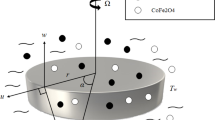Abstract
Tracers commonly used in experimental flow studies are mostly nocuous to the environment and human health. Particularly, in large flow installations, this can become a problem. In this study, a solution of this problem is presented, based on using water-soluble vitamins. Five of them are examined here for their applicability in flow studies. Vitamins B2 and B6 turned out to be the most promising candidates, and the dependency of their fluorescence intensity on parameters like concentration, laser energy, temperature, and pH are determined for two commonly used laser excitation wavelengths (532, 355 nm). Two examples of application in a static mixer and a spray flow are shown and demonstrate the applicability of the vitamin tracers.


















Similar content being viewed by others
References
Aaron J-J, Winefordner JD (1972) Fluorimetric and phosphorimetric characteristics of several vitamins. Talanta 19:21–29
Drössler P, Holzer W, Penzkofer A, Hegemann P (2002) pH dependence of the absorption and emission behaviour of riboflavin in aqueous solution. Chem Phys 282:429–439
Duwel I, Schorr J, Wolfrum J, Schulz C (2004) Laser-induced fluorescence of tracers dissolved in evaporating droplets. Appl Phys B-Lasers Opt 78:127–131
Feng F, Wang K, Chen Z, Chen Q, Lin J, Huang S (2004) Flow injection renewable drops spectrofluorimetry for sequential determinations of vitamins B1, B2 and B6. Anal Chim Acta 527:187–193
García L, Blázquez S, San Andrés MP, Vera S (2001) Determination of thiamine, riboflavin and pyridoxine in pharmaceuticals by synchronous fluorescence spectrometry in organized media. Anal Chim Acta 434:193–199
Guilbault G (1973) Practical fluorescence. New York, Marcel Dekker, Inc. 0-8247–1263-3
Hagemeier T, Hartmann M, Kühle M, Thévenin D, Zähringer K (2012) Experimental characterization of thin films, droplets and rivulets using LED fluorescence. Exp Fluids 52:361–374. doi:10.1007/s00348-011-1232-x
Hubmann B, Monnier D, Roth M (1969) Une methode de dosage rapide et precise de l’acide ascorbique; application à la mesure de taux plasmatiques. Clin Chim Acta 25:161–166
Kling K, Mewes D (2004) Two-colour laser induced fluorescence for the quantification of micro- and macromixing in stirred vessels. Chem Eng Sci 59:1523–1528
Lehwald A, Thévenin D, Zähringer K (2010) Quantifying macro-mixing and micro-mixing in a static mixer using two-tracer laser-induced fluorescence. Exp Fluids 48:823–836. doi:10.1007/s00348-009-0769-4
Lehwald A, Janiga G, Thévenin D, Zähringer K (2012) Simultaneous investigation of macro- and micro-mixing in a static mixer. Chem Eng Sci 79:8–18. doi:10.1016/j.ces.2012.05.026
Lenci F, Checcucci G, Sgarbossa A, Martin MM, Plaza P, Angelini N (2005) Fluorescent biomolecules. In: Bassani F, Liedl GL, Wyder P (eds) Encyclopedia of condensed matter physics. Oxford, Elsevier, pp 222–235
Llorent-Martínez EJ, García-Reyes JF, Ortega-Barrales P, Molina-Díaz A (2006) A multicommuted fluorescence-based sensing system for simultaneous determination of vitamins B2 and B6. Anal Chim Acta 555:128–133
Mills A (2005) Oxygen indicators and intelligent inks for packaging food. Chem Soc Rev 34:1003–1011
Passannante AJ, Avioli LV (1966) Studies on the ultraviolet fluorescence of vitamin D and related compounds on acid-alcohol solutions. Anal Biochem 15:287–295
Schulman SG, Di QQ, Juchum J (1999) Organic chemistry applications of fluorescence spectroscopy. In: Lindon J (ed) Encyclopedia of spectroscopy and spectrometry. Oxford, Elsevier, pp 1718–1725
Schulz C, Sick V (2005) Tracer-LIF diagnostics: quantitative measurement of fuel concentration, temperature and fuel/air ratio in practical combustion systems. Prog Energy Combust Sci 31:75
Tyagi A, Penzkofer A (2010) Fluorescence spectroscopic behaviour of folic acid. Chem Phys 367:83–92
Tymecki T, Rejnis M, Pokrzywnicka M, Strzelak K, Koncki R (2012) Fluorimetric detector and sensor for flow analysis made of light emitting diodes. Anal Chim Acta 721:92–96
Wang Y, Zhu PH, Tian T, Tang J, Wang L, Hu XY (2011) Synchronous fluorescence as a rapid method for the simultaneous determination of folic acid and riboflavin in nutritional beverages. J Agric Food Chem 59:12629–12634
Acknowledgments
The author would like to thank her student Wiebke Seydel for her help and patience in doing the parametric experiments in the cuvettes. Christian Gollmer helped for doing the experiments in the mixer and spray configuration. Their contribution was much appreciated.
Author information
Authors and Affiliations
Corresponding author
Rights and permissions
About this article
Cite this article
Zähringer, K. The use of vitamins as tracer dyes for laser-induced fluorescence in liquid flow applications. Exp Fluids 55, 1712 (2014). https://doi.org/10.1007/s00348-014-1712-x
Received:
Revised:
Accepted:
Published:
DOI: https://doi.org/10.1007/s00348-014-1712-x




